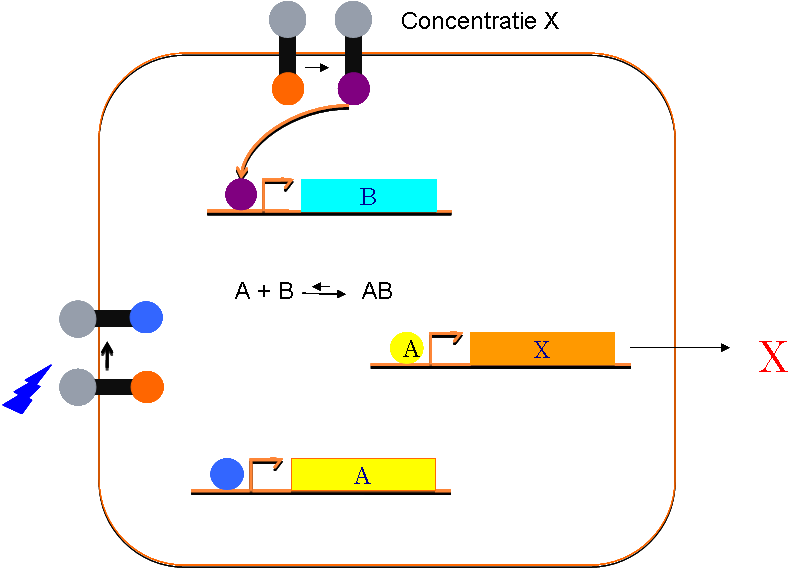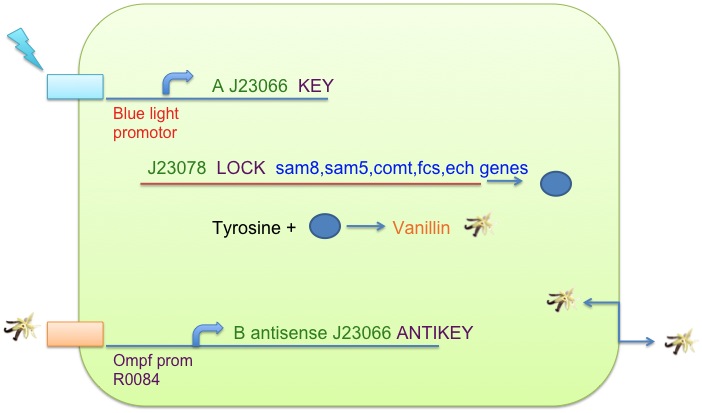Team:KULeuven/Abstract
From 2009.igem.org
(→Essencia Coli) |
|||
| Line 12: | Line 12: | ||
The complete system with the corresponding biobricks can be seen below, as well as the biobricks which still need to be created from the genes (blue light receptor and vanillin synthesis) | The complete system with the corresponding biobricks can be seen below, as well as the biobricks which still need to be created from the genes (blue light receptor and vanillin synthesis) | ||
[[Image:Missbluevanilla.jpg|center|thumb|400px|Overview of the system with corresponding biobricks]] | [[Image:Missbluevanilla.jpg|center|thumb|400px|Overview of the system with corresponding biobricks]] | ||
| + | |||
| + | |||
| + | |||
| + | ---- | ||
| + | Vanilla Perfume, the story of a control bacteria | ||
| + | |||
| + | ‘Essenca Coli’ is a Vanillin producing bacteria equipped with a control system that keeps the concentration of the molecule at a constant level. The novelty of the project is the feedback mechanism. Vanillin synthesis is initiated by irradiation with a blue light. The preferred concentration value can be modulated using the intensity of that light. At the same time the bacteria measures the amount of Vanillin outside the cell and controls its production to maintain the set point. An additional advantage lies in the universal nature of the system. The concept can easily be applied to other flavours and odours or even vitamins and nutrients: any molecule that requires a constant concentration. | ||
| + | |||
| + | |||
| + | (kunnen jullie dit even nakijken op fouten? het is een soort abstract, wat ik voorlopig dacht te gebruiken voor de sponsor-mails. let niet teveel op de titel; ik vond die gewoon leuk, maar ik heb die eigenlijk niet nodig ;-) Katrien) | ||
Revision as of 17:43, 23 July 2009
Essencia Coli
The main idea is to synthesize Vanillin and control the synthesis such that the concentration of Vanillin stays constant. The value of this concentration can be set by intensity of blue light. This concept however can be extended to other molecules that need to be kept at a certain concentration, this can be for example other odors or flavours or something completely different like essential nutrients or vitamins. In the figure on the left an illustration of the controlling mechanism is explained. In here Vanillin is changed to molecule 'X' because of it's universal charachter. In the figure the cell synthesizes molecule 'X' and at the same time measures the concentration of this molecule outside the cell and uses this measurement to control the synthesis and keep the concentration outside the cell constant. This concentration can then be modulated using light intensity.
For proof of concept the molecule 'X' is set to be vanillin, to extend this principle to other molecule all that is needed is a concentration dependent receptor. The light receptor will activate transcription of A on irradiation of blue light. This will stimulate synthesis of Vanillin. The concentration vanillin outside the cell is measured with a vanillin receptor. The activation of the vanillin receptor will result in transcription of B and block the actions of A. The activation of synthesis by A is done with a key/lock setup. The translation of the Vanillin synthesizing proteins need a key in order to translate, A will provide the key. Therefore upon irradiation of blue light the required proteins will be translated. The inhibition of A by B is done by translating an anti-sense mRNA of A, blocking the actions of the key. Thus, if the concentration of vanillin increases, the synthesis of vanillin-synthesizing proteins will decrease untill it stops completely.
The complete system with the corresponding biobricks can be seen below, as well as the biobricks which still need to be created from the genes (blue light receptor and vanillin synthesis)
Vanilla Perfume, the story of a control bacteria
‘Essenca Coli’ is a Vanillin producing bacteria equipped with a control system that keeps the concentration of the molecule at a constant level. The novelty of the project is the feedback mechanism. Vanillin synthesis is initiated by irradiation with a blue light. The preferred concentration value can be modulated using the intensity of that light. At the same time the bacteria measures the amount of Vanillin outside the cell and controls its production to maintain the set point. An additional advantage lies in the universal nature of the system. The concept can easily be applied to other flavours and odours or even vitamins and nutrients: any molecule that requires a constant concentration.
(kunnen jullie dit even nakijken op fouten? het is een soort abstract, wat ik voorlopig dacht te gebruiken voor de sponsor-mails. let niet teveel op de titel; ik vond die gewoon leuk, maar ik heb die eigenlijk niet nodig ;-) Katrien)
 "
"

